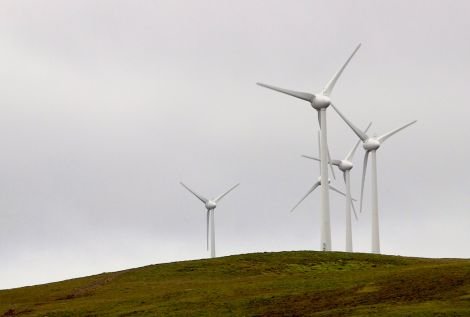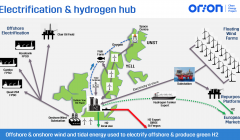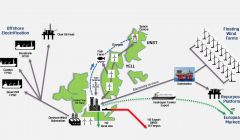News / SIC looks to Yell to kick-start hydrogen economy
Heating and transport are two ways in which hydrogen could be used.
THE IDEA of turning surplus energy from a wind farm in Yell into hydrogen to use for heating and transport is being explored – leading to hopes that it could kick-start other local renewable operators into doing the same.
The plans, led by the Shetland Island Council’s (SIC) carbon management team in conjunction with the North Yell Development Council, take inspiration from similar hydrogen schemes in Orkney and the Western Isles.
SIC carbon and energy officer Sean Haughey, who is at the forefront of the project, said hydrogen produced from the five-turbine, 4.5MW Garth wind farm in Yell – which is run by the development council for the benefit of the community – could heat the Baltasound school in Unst five or six times over.
He added that at the moment the Garth wind farm would be the largest renewable hydrogen production project in the UK.
The process would involve taking ‘curtailed’ energy from wind farms, when there is not enough capacity in the network to take in any more power, and putting it through electrolyser to turn water into hydrogen and oxygen.
Haughey said the cost of producing hydrogen comes out “very favourably” compared to other forms of energy, and it is anticipated that a forthcoming islands deal – which could bring millions of government funding to the north and west of Scotland – will seek to support this growing industry.
“The overall cost will depend on exactly how big we go with it,” he said.
“It’s quite modular – you can start off quite small and you can add on to it as you need. Which is probably what we’d do, start off with a small test site and scale it up to full size within a few years, depending on how successful it was.
“I think one thing we’d be looking to hopefully do is to kick-start other places in Shetland to look at hydrogen. We’ve already had a few wind operators or people with turbines being interested in hydrogen because they’re seeing what’s going on in Orkney.
Become a member of Shetland News
“I think with the council’s support, and with Garth Wind very supportive of it as well, it’s the ideal project to get things started.”
The proposal is due to be passed to the council’s corporate management team in January in the view of a business case being prepared.
Hydrogen in Shetland is not an entirely new topic, with the PURE Energy Centre – based in Unst – researching the production and storage of the gas for well over a decade.
But the possible Garth wind farm project would be a major milestone in hydrogen for Shetland.
The hydrogen projects in Orkney received a large amount of funding due to their novel nature, and council staff in Shetland do not want the isles to slip behind any further.
In the neighbouring islands, the hydrogen is used in a number of ways, from transport, heating and auxiliary power for ferries. It can also be used in electric cars to provide back-up when their charge runs out.
“Shetland is quite far behind Orkney, but also in the Western Isles you’ve got a lot of folk into hydrogen, so Shetland has been a bit slow to get the ball rolling with hydrogen,” Haughey said.
“This is our first opportunity to have a viable project and push forward and start catching up with the rest of the island groups.”
“It is cheaper than heating oil, and if you think the council has 15 major heating systems needing replaced in the next five years, there’s a market for it there,” carbon management team leader Mary Lisk added.
“There’s already hydrogen buses in Aberdeen, Fife and Dundee, and they’re grant funded through the UK government. So if we need buses replaced, you could potentially start looking at hydrogen buses.
“Looking at our own internal ferries, if we could reduce the cost of them by producing local fuel from constrained wind – it’s a win win. It’s definitely an area which is going to expand, and probably quite rapidly.”
The exact arrangements for the proposed hydrogen production from the Garth wind farm have yet to be decided, but it could see the council owning the electrolyser and subsequently receiving the energy from the wind farm owners.
“We use wind from Fetlar to heat the school, and we pay a nominal fee to the development company there, so it would be the same idea. But obviously it has to be discussed,” Lisk said.
The electrolyser would in theory be the size of a shipping container and there is already a site in mind which has the backing of local people.
Even though it would be produced on the island, the hydrogen could be transported safely on ferries to mainland Shetland – similar to how it is produced on the island of Eday in Orkney.
The problem with developing hydrogen in Shetland, however, is that there needs to be a market for it, with heating and transport the two likely beneficiaries.
“Heating seems to be the easy one to go, because it’s very scalable,” Haughey said.
“At the council we’ve got schools that are small and large, you’ve got care homes – so we’ve got a range of loads that could be used.”
Hydrogen produced locally in Shetland could also save the oil and gas industry, which uses it in some of its chemical processes, from having to ship it up from south.
But it is not just hydrogen that could be of worth. The other by-product of electrolysis, oxygen, is used by the local aquaculture industry.
“We looked at using oxygen, and although it wasn’t seen to be financially viable down in Orkney, there’s a lot of fishing farming aquaculture in Shetland that ships up a lot of oxygen,” Haughey explained.
“It’s part of the business case to look at also using the oxygen. You end up producing by mass about eight times more oxygen than you do hydrogen.”
One stimulus for the Yell idea came from the council developing a local heat and energy efficiency strategy, which is going to become a statutory duty for all of Scotland’s local authorities.
Large proposed wind farms like the 103-turbine Viking Energy development, which need an interconnector cable to export energy to the Scottish mainland, could also technically produce hydrogen.
But while “constraint is not going to go away from Shetland”, the larger turbines will “likely get first dibs on space on the interconnector” – meaning there is less prospect of them being curtailed.
“They are larger turbines, it’s more difficult for them to turn off,” Haughey said.
“But essentially smaller operators such as Garth wind would probably be one the first to get asked to switch off in the case of constraint, so there will be that constraint there for hydrogen to be generated.”
“There is going to be a hydrogen economy,” Lisk added.
“Reading through the islands deal that’s being discussed, it’s fairly certain that one of the areas that will be funded is hydrogen development and hydrogen economies.
“That generates jobs. Shetland is saying we want to generate jobs and pull in young families etc, but we have a lot of guys on the island that are good qualified engineers and have a technical background, and if hydrogen was to start producing those jobs and opportunities, it could be one of the threads to strengthen the attraction of the islands to young people.”
For the North Yell Development Council, having the council in tow has enabled the community group to take the proposal further than just an improbable idea.
“We are enthusiastic about the prospect of a hydrogen making project,” director Andrew Nisbet said.
“We are also enthusiastic about working with the SIC on this as we need a partner. As a small community group we do not have the capacity to undertake this ourselves.
“The idea is it would use power from our wind farm when the farm is constrained, i.e. when the Shetland grid is not able to take all our power.
“The constraint represents a loss of potential earnings for our community, although the wind farm is viable even with the constraint. Hydrogen is a promising alternative as a fuel for road vehicles and also as a marine fuel.
“Projects such as the one we are looking at are very important to develop the use of hydrogen to the point where it is commercially viable.”
Become a member of Shetland News
Shetland News is asking its readers to consider paying for membership to get additional perks:
- Removal of third-party ads;
- Bookmark posts to read later;
- Exclusive curated weekly newsletter;
- Hide membership messages;
- Comments open for discussion.
If you appreciate what we do and feel strongly about impartial local journalism, then please become a member of Shetland News by either making a single payment, or setting up a monthly, quarterly or yearly subscription.
















































































